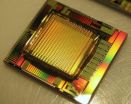New insight into why haste makes waste
2012-11-07
(Press-News.org) Why do our brains make more mistakes when we act quickly?
A new study demonstrates how the brain follows Ben Franklin's famous dictum, "Take time for all things: great haste makes great waste."
The research – conducted by Research Assistant Professor Richard Heitz and Jeffrey Schall, Ingram Professor of Neuroscience, at Vanderbilt University – has found that the brain actually switches into a special mode when pushed to make rapid decisions.
The study was published Nov. 7 in the journal Neuron.
"This is a question that is very basic to our experience as human beings, and something that we encounter on a daily basis," Heitz, who designed and carried out the study, said. "If we can understand how our brain changes when we are pushed to respond faster, we have gone a long way toward understanding the decision-making process in general."
The tradeoff between speed and accuracy is a universal aspect of decision making that has been studied extensively in humans. Numerous behavioral and brain-mapping studies have supported a simple model: The brain uses the same basic method to make both deliberate and rapid decisions. In order to shorten the decision-making time, the brain simply reduces the cumulative amount of neuronal activity it requires before making a decision. Because the brain must make snap decisions based on less information than it uses for slower decisions, the likelihood that it will make mistakes increases.
However, none of the previous experiments were capable of studying the decision-making process at the level of individual brain cells called neurons. Although it is easy to set up tests with human subjects that prompt them to switch between speedy and accurate decision making, the methods for measuring human brain activity do not have the required speed or resolution. On the other hand, it is possible to measure the activity of individual neurons in monkeys, but no one knew how to train them to vary the speed of their decision making.
The scientists developed a method for teaching monkeys to switch back and forth between fast and accurate decision making in a task that involved picking out a target from an array of objects presented on a computer screen. In one experimental condition, monkeys learned that only accurate responses would be rewarded. In another condition, they learned that making some mistakes was okay, as long as the decisions were fast. Meanwhile, the researchers monitored signals from single neurons in their prefrontal cortex – the area in the brain dedicated to higher cognition.
"Our tests are like two different game shows. One – call it Fast Fury – is like Jeopardy. In order to answer a question you must be the first to hit the buzzer. Buzzing in and answering incorrectly is bad, but being slower than the other contestant means you will never earn a reward," Heitz said. "That is much different than the second game show – call it High Stakes Showdown – where buzzing in at any time gives you the opportunity to answer a question, but being wrong results in a serious penalty.
"The first thing you see is that neural activity of the player of Fast Fury jumps up even before the question is read," Heitz said. "The subjective experience of getting ready that we all experience appears to be reflected in the background activity of neurons in prefrontal cortex." In comparison, the neural activity drops to extremely low levels during High Stakes Showdown while the player waits to hit the buzzer.
This picture differs substantially with the standing theory that the brain uses the same process for all types of decisions. "Our second observation, in particular, was really startling," Schall said. "It really flies in the face of what we thought we knew about decision-making."
Returning to the game show example, consider what happens when contestants in Fast Fury and High Stakes Showdown are given identical questions. The activity of the prefrontal cortex neurons increases while observers decide how to respond. But the new data suggests that this activity is amplified during Fast Fury and suppressed during High Stakes Showdown.
"What this means is that identical information presented to the brain is analyzed differently under speed stress than under accuracy stress," Schall said.
These unexpected results are controversial and important because they are at odds with currently accepted mathematical models of decision making, which are being used to understand psychiatric and neurological disorders. For example, people with certain types of brain damage seem to get stuck in a hasty, impulsive mode of deciding, and the models provide some indication for how this might happen mechanically in the brain. Heitz and Schall have shown how these mathematical models can be modified to make them consistent with the new results.
So, does haste inevitably make waste? According to Schall, it all depends. "Haste makes waste when a mistake entails dire consequences. But there are many situations in life when the cost of not acting is higher than making an error in judgment. For example, if the decision is whether or not to shut down a nuclear reactor in the presence of a potential meltdown, I'd prefer haste."
### The research was funded by National Institutes of Health Grants F32-EY019851, R01-EY08890, P30-EY08126, P30-HD015052, and the E. Bronson Ingram Chair in Neuroscience.
ELSE PRESS RELEASES FROM THIS DATE:
2012-11-07
VIDEO:
This is an example of one image from each of the visual categories used in the structured SSD training (geometric shapes, Hebrew letters, textures, body postures, everyday objects, houses, and...
Click here for more information.
Areas of the brain in blind people can learn to process visual input through the use of sound, even after years or perhaps even lifelong blindness, according to new research reported in the November issue of the Cell Press journal Neuron. The findings ...
2012-11-07
Ottawa, Canada (November 7, 2012) – Researchers at Dalhousie University have discovered a new technique using "computer-aided" drug design that may lead to an entirely new approach in the treatment of Alzheimer's disease (AD).
"Alzheimer's is a devastating disease for which no truly disease-modifying drugs are available. Our approach is completely novel. We explore how the human body attempts to protect itself from Alzheimer's, and then we exploit this to develop an entirely new approach to therapeutics," explained Dr. Weaver, a professor at Dalhousie University, ...
2012-11-07
BLOOMINGTON, Ind. -- Rapid advances in the new and developing field of restoration sedimentology will be needed to protect the world's river deltas from an array of threats, Indiana University Bloomington geologist Douglas A. Edmonds writes in the journal Nature Geoscience.
The commentary, published this week in the November issue, addresses the fact that land is disappearing from river deltas at alarming rates. And deltas are extraordinarily important: They are ecologically rich and productive, and they are home to about 10 percent of the world's population.
"There's ...
2012-11-07
CHESTNUT HILL, MA (November 7, 2012) – In a digital age where dissatisfied consumers vent their concerns through biting viral videos, nasty blog posts or negative online comments, managers need to develop strategies to soothe angry customers in person as well as online, according to a new study in the latest edition of the Journal of Service Research.
In a study that explores the changing ways in which customers express their emotions, the researchers found that anger can quickly fuel negative word-of-mouth commentary to fellow consumers, family and friends, as well as ...
2012-11-07
When a patient is diagnosed with type 2 diabetes, the disease has usually already progressed over several years and damage to areas such as blood vessels and eyes has already taken place. To find a test that indicates who is at risk at an early stage would be valuable, as it would enable preventive treatment to be put in place.
Researchers at Lund University have now identified a promising candidate for a test of this kind. The findings have been published in the journal Cell Metabolism.
"We have shown that individuals who have above-average levels of a protein called ...
2012-11-07
A team of Brazilian physicists working with neuroscientists studying freely behaving rats have found that their neurons often act in precise coordination over time, in a study about to be published in EPJ B. These findings stem from the work of Bruno Silva, a researcher at Bahia Federal University in Salvador, and his colleagues from other universities in the Northeastern region of Brazil, and suggest that neuronal networks' memory could be explored in the future.
Because neurons are connected with each other, acting as operational units in the brain, they can be considered ...
2012-11-07
Faced with the same threat, city and country birds do not react in the same way despite being from the same species. According to a new study, urban birds have changed their anti-predator behaviour in new environments.
When a bird is faced with a predator, its only objective is to escape. However, city birds do not react in the same way as their countryside counterparts, despite being from the same species. Urbanisation plays an influential role in their survival strategies.
To study this phenomenon, Juan Diego Ibáñez-Álamo, researcher at the University of Granada ...
2012-11-07
Fast and ultrasensitive optical systems are gaining increasing significance and are being used in a diverse range of applications, for example, in imaging procedures in the fields of medicine and biology, in astronomy and in safety engineering for the automotive industry. Frequently the challenge lies in being able to record high-quality images under extremely low light conditions. Modern photo detectors for image capture typically reach their limits here. They frequently work with light-sensitive electronic components that are based on CMOS (Complementary Metal Oxide ...
2012-11-07
Power supply is the backbone of our modern economy. Nearly every aspect of life depends on electrically-operated devices. When the flow of power stops, it is not just the lights that go out. In the supermarket, the automatic teller machines and cash registers stop working. Even telephones, radios and televisions become paralyzed. If the shortage lasts a long time the supply of hot water, gas and fuel and the functioning of respirators at intensive care units in nursing homes or at private homes is at risk.
The causes of this dreadful scenario can range from natural disasters ...
2012-11-07
Jerusalem, Nov. 7, 2012 -- Common wisdom has it that if the visual cortex in the brain is deprived of visual information in early infanthood, it may never develop properly its functional specialization, making sight restoration later in life almost impossible.
Scientists at the Hebrew University of Jerusalem and in France have now shown that blind people – using specialized photographic and sound equipment – can actually "see" and describe objects and even identify letters and words.
The new study by a team of researchers, led by Prof. Amir Amedi of the Edmond and ...
LAST 30 PRESS RELEASES:
[Press-News.org] New insight into why haste makes waste




